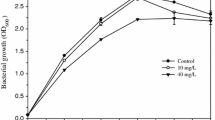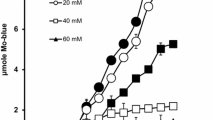Abstract
The kinetics of chromium(VI) reduction by Pseudomonas aeruginosa (P. aeruginosa) and Escherichia coli (E. coli) was studied under both pure and mixed cultures. Initially, the study of kinetics was performed in pure culture. It was observed that the growth of the two bacteria was both inhibited in the presence of chromium(VI). The maximum specific growth rate (μ m ) of P. aeruginosa decreased from 2.3942 h−1 (without Cr(VI)) to 1.8551 h−1 (with Cr(VI)). Under the mixed culture, the growth of E. coli was inhibited by P. aeruginosa. The maximum specific growth rate (μ m ) of E. coli decreased form 0.871 h−1 (in pure culture) to 0.153 h−1 (in mixed culture). When the concentration of each bacterium was 4.5 × 108 cells ml−1, the half-velocity reduction rate constant (K C) and the maximum specific reduction rate constant (v max) of chromium(VI) were 80.05 mg chromium(VI) l−1 and 3.674 mg chromium(VI) cells−1 h−1, respectively. The results showed that the simulation appeared in good agreement with the experimental data, supporting the series of mathematical models represented the bacteria growth and chromium(VI) reduction in both pure and mixed cultures usefully.





Similar content being viewed by others
References
Alfenore S (1999) Interaction du type killer chez Saccharomyces cerevisiae Etudes physiologiques et cinétiques, Quantification et modélisation. Thèse INP Toulouse, France
Bussey H, Saville D, Huntchins K (1979) Binding of yeast killer toxin to a cell wall receptor on sensitive Saccharomyces cerevisiae. J Bacteriol 140:888–892
Clesceri LS, Greenberg AE, Trussel RR (1989) Standard methods for the examination of water and waste water, 17th edn. American Public Health Association, Washington, DC
Cornu M, Kalmokoff M, Flandrois JP (2002) Modelling the competitive growth of Listeria monocytogenes and Listeria innocua in enrichment broths. Int J Food Microbiol 73(2–3):261–274
Dalgaard P (2002) Modelling and prediction the shelf-life of seafood. In: Bremmer HA (ed) Safety and quality issues in fish processing. Woodhead Publishing, UK
Gompertz B (1825) On the nature of the function expressive of the law of human mortality and on a new mode of determining the value of life contingencies. Philos Trans R Soc Lond 115:513–585
Guha H, Jayachandran K, Maurrasse F (2001) Kinetics of chromium(VI) reduction by a type strain Shewanella alga under different growth conditions. Environ Pollut 115:209–218
Hassan HM, Fridovich I (1980) Mechanism of the antibiotic action of pyocyanine. J Bacteriol 141:156
Li XF, Wei WZ, Zeng XD (2006) Study on chromium(VI) reduction kinetics by Pseudomonas aeruginosa using a combined system of acoustic wave impedance analyzer and UV–Vis spectrophotometer. Curr Microbiol 53:249–254
Megharaj M, Avudainayagam S, Naidu R (2003) Toxicity of hexavalent chromium and its reduction by bacteria isolated from soil contaminated with tannery waste. Curr Microbiol 47:51–54
Monod J (1949) The growth of bacterial cultures. Annu Rev Microbiol 3:371–394
Muramatsu H, Tamiya E, Karube I (1988) Computation of equivalent circuit parameters of quartz crystals in contact with liquids and study of liquid properties. Anal Chem 60:2142–2146
Patterson JW (1985) Industrial wastewater treatment technology. Butterworth Publication, Stoneham, MA
Smith WL, Gadd GM (2000) Reduction and precipitation of chromate by mixed culture sulphate reducing bacterial biofilm. J Appl Microbiol 88:983–991
Stearns DM, Belbruno JJ, Wetterhahn KE (1995) A prediction of chromium(III) accumulation in humans from chromium dietary supplements. FASEB J 9:1650–1657
Tao H, Wei WZ, Zhang SF (2004) Photocatalytic inhibitory effect of immobilized TiO2 semiconductor on the growth of Escherichia coli studied by acoustic wave impedance analysis. J Photochem Photobiol A 161:193–199
Wang XH, Li ZX, Guo YZ (1995) Observation of inhibitory activity of the metabolites of Pseudomonas aeruginosa against Gram-negative bacteria. Chin J Antibiot 20:308–310
Wang YT, Shen H (1997) Modeling chromium(VI) reduction by pure bacterial cultures. Water Res 31:727–732
Yamamoto K, Kato J, Yano T, Ohtake H (1993) Kinetics and modeling of hexavalent chromium reduction in Enterobacter cloace. Biotechnol Bioeng 41:129–133
Zhang JZ, Wei WZ, Mao YA, Chai LY (2001) Monitoring of bio-oxidation process of ferrous ion by using piezoelectric impedance analysis. Curr Microbiol 43:83–88
Author information
Authors and Affiliations
Corresponding author
Rights and permissions
About this article
Cite this article
Kong, B., Zeng, X., Liu, X. et al. Kinetic Study and Mathematical Modeling of Chromium(VI) Reduction and Microorganism Growth Under Mixed Culture. Curr Microbiol 59, 565–571 (2009). https://doi.org/10.1007/s00284-009-9478-8
Received:
Accepted:
Published:
Issue Date:
DOI: https://doi.org/10.1007/s00284-009-9478-8




